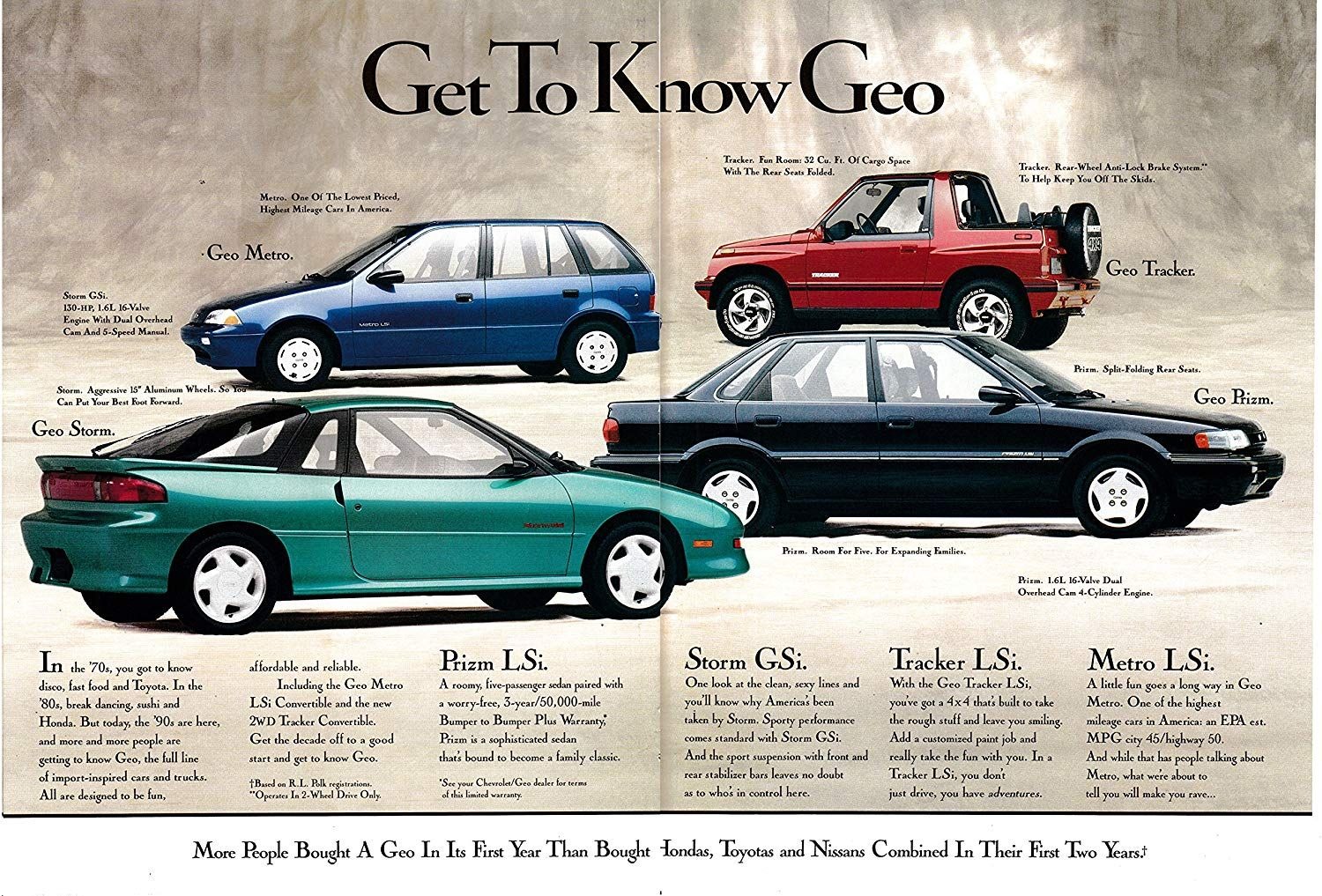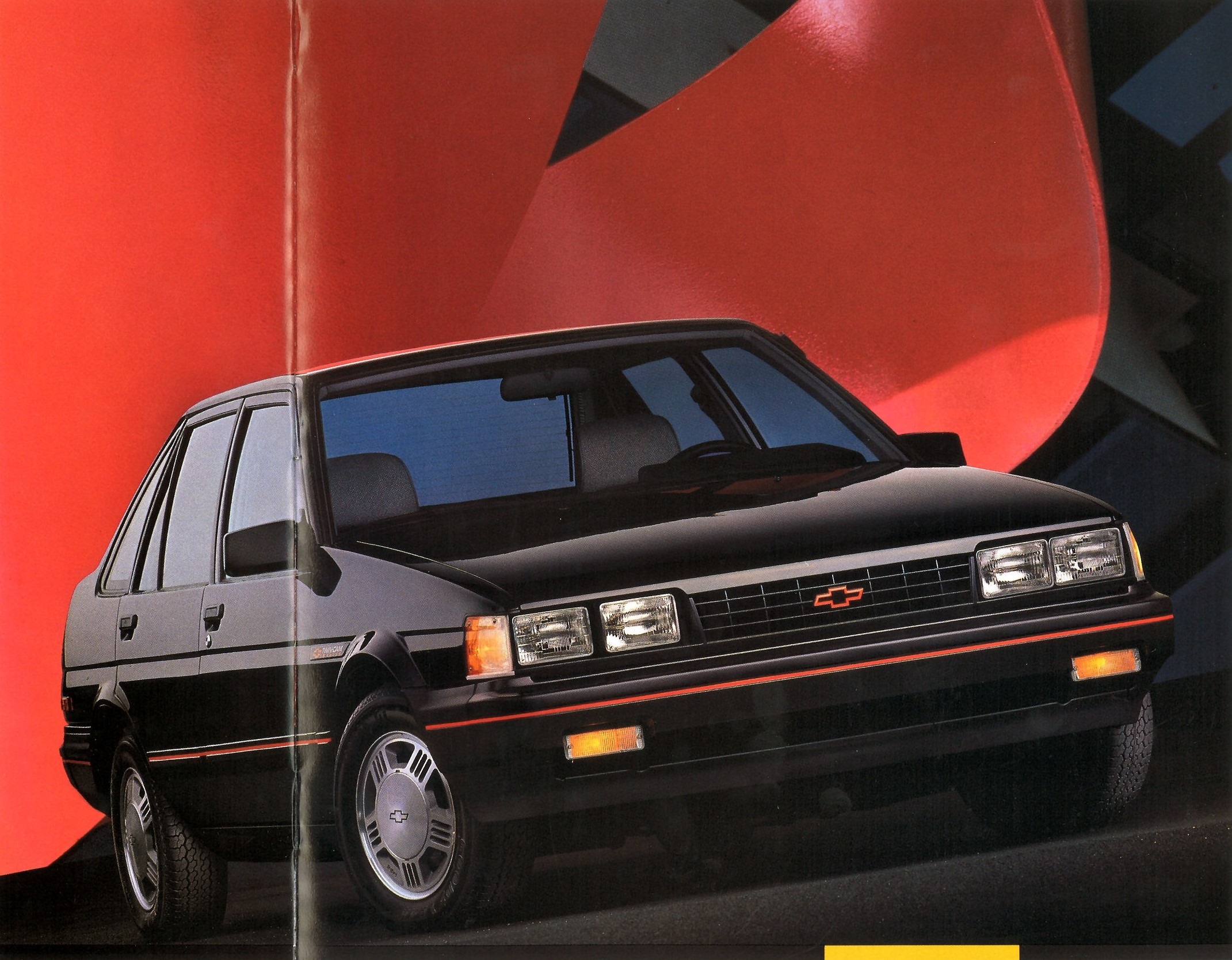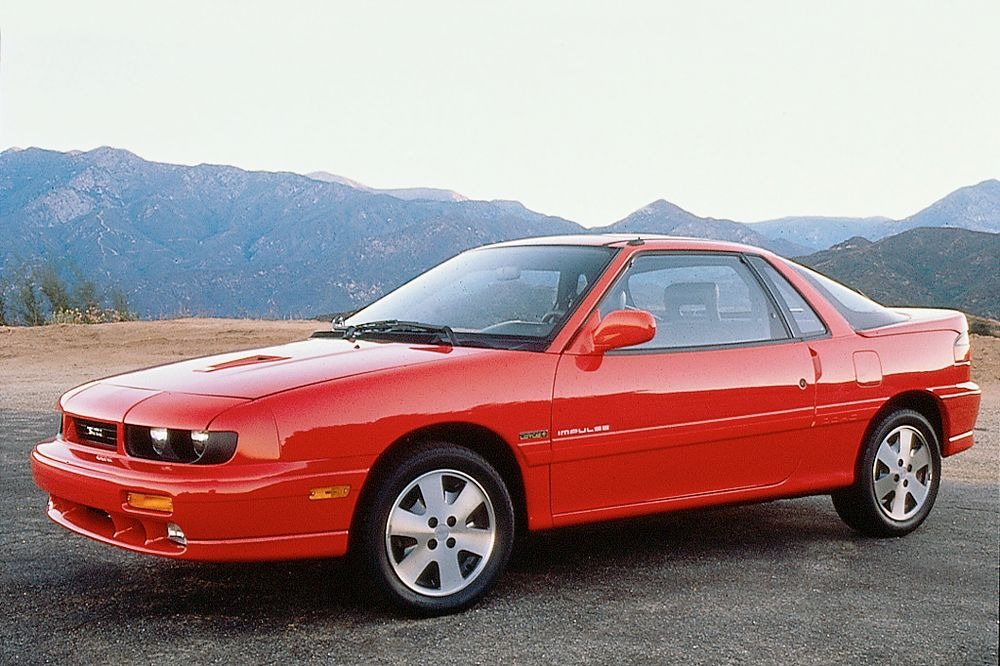From the mid-1980s through the 1990s and even into the 2000s, Americans could buy Japanese cars from General Motors. Geo was General Motors’ answer to popular imports from the likes of Toyota. It was a GM brand that didn’t sell GM vehicles and today, many of its cars are forgotten and disappearing from America’s roads. One of those cars is the Geo Storm, a car that wasn’t just an economical way of getting around, since GM offered a legitimate performance variant and even a shooting brake!
Last time on Holy Grails, readers ColoradoFX4, great falls green, and Jack Trade all nominated the Chevrolet Lumina Z34. In the not-too-distant past, General Motors used to produce a slew of front-wheel-drive coupes. Most of these cars were little more than efficient transportation with some style, but the General did pump out a few that are worth remembering. Available in just coupe form, Chevy Lumina buyers could opt for the high-performance Lumina Z34. Lumina Z34s came with a sport suspension package, a body kit, sporty, overstuffed seats, and a dual exhaust. Under the hood sat a 3.4-liter V6 that made 210 horses and 215 lb-ft torque. It was not the fastest car of its type or even the rarest, but it was a hotter version of a car forgotten by enthusiasts today.
I believe today’s grail follows a similar idea.

The Geo Storm was a common car. Perhaps some of you lovely readers drove one of these in college or at least knew someone with them. And for the younger folks in our audience, maybe you got one of these as a worn hand-me-down during your days in high school. I say that, but the only Geos I remember from my high school parking lot circa 2011 were beaten-down Metros. The more I think about this, the more I fear that I cannot remember when was the last time I’ve seen a Geo Storm in the wild. Sure, I’ve seen photos of Storms at car shows like Radwood, but shows like that are bound to lure these out of hiding. When was the last time you’ve seen someone using a Storm as a daily driver?
Really, it seems that so many Geo products are disappearing from American roads. I see Trackers getting beaten up on Gambler 500s and the occasional Metro convertible, but I can’t tell you when was the time I’ve seen a Prizm. And I’m not sure I’ve ever seen a Spectrum in real life.
Geo Had A Lineup Of Bangers

As I wrote in our last entry, General Motors of the 1980s struggled to maintain momentum. In 1984, GM’s brands hoarded 44.6 percent of the car market. But GM couldn’t hold it all and by 1987, the brands lost their grip, grasping for 36.6 percent market share. In 1992, CNN explained that General Motors made a bet on small fuel-efficient front-wheel-drive cars during a time when the American buying public was still looking for larger vehicles. In the last Holy Grails, I explained the GM-10 program, a development program designed to replace the Chevrolet Celebrity, Pontiac 6000, Oldsmobile Cutlass Supreme, and Buick Century with a coupe, a sedan, and a wagon for each brand. Each of those cars would be similar underneath.
During the 1980s, General Motors also had a knack for rebadging imported vehicles. The Chevy Chevette-based Pontiac T-1000 died and made way for the 1988 Pontiac LeMans. This was a car designed by Opel in Europe, sold as the Kadett, and built in South Korea by Daewoo, where it was badged as the LeMans. The Chevy Sprint was another weird captive import. Chevy abandoned the development of the M-body, selling it to Suzuki in exchange for a five percent stake. Over in Japan, the car would be known as the Suzuki Cultus and in 1984, it came back to America as the Chevrolet Sprint. And don’t forget about the 1986 Chevrolet Nova, a vehicle built under the famous New United Motor Manufacturing Inc (NUMMI) partnership with Toyota. The Nova, despite the historic name, was really a Toyota Sprinter at heart.

In 1988, the New York Times reported that General Motors had a new plan for its imports. The Chevy Nova would die in 1988, to be replaced by something called the Geo Prizm. As the publication noted, Chevrolet’s marketers felt that the Nova was outdated when it was new and that because it was branded a Chevy, buyers thought it was a domestic product. Geo was created as a subsidiary of Chevrolet to house GM’s captive imports. General Motors reportedly hoped to lure young buyers who might otherwise buy an import like a Toyota. In hindsight, that seemed like an odd plan. General Motors would stop you from buying a Toyota by selling you a Toyota that calls itself something else.
When Geo launched in 1989, the lineup consisted of the Geo Prizm, the Metro, the Spectrum, and the Tracker. The Prizm was still a Toyota Sprinter, the Spectrum was an Isuzu I-Mark, and the Tracker was developed in a joint venture between General Motors of Canada and Suzuki. All of these cars were pretty awesome in their own ways. I’ve off-roaded in Trackers over the years and the little SUV-lets are beasts. To this day I want one for a Gambler 500 rig but I’ve just never found one in good enough shape.

Of course, the Metro needs no introduction. The second-generation Geo Metro is famous for its frugality. This is a car that gets 52 mpg on the highway without using a hybrid system or a diesel engine. Mind you, that’s 52 mpg after the EPA revised fuel economy ratings in 2007. Before revisions, the Metro was rated at 58 mpg.
There was also some meddling behind the Metro. As United Press International reported in 1991, GM brass prevented Suzuki from selling its own super frugal car in the United States. Apparently, this was done in an effort to kneecap the perception that Japanese automakers build more fuel-efficient cars than American automakers.
Storm Warning

That brings us to the Storm. When it was time to put the Isuzu-based Spectrum to pasture, General Motors asked for a replacement. In 1990, Isuzu came out with the second generation of the Impulse, which would get slightly restyled and sold as the Geo Storm. Here’s what Geo had to say about it:
Geo Storm is the new generation of performance coupe, for a new generation of enthusiasts.
The shape is aggressive, the technology leading-edge and the price affordable.
Geo Storm 2 + 2 Coupe features include a spirited 12-valve engine, fully independent suspension, folding rear seat and complete analog instrumentation. A driver’s side Supplemental Inflatable Restraint System (air bag) is a standard safety feature.
Geo Storm GSi is the full-blown Storm, featuring distinctive exterior and interior styling, a high-performance 16-valve engine and Sport Suspension.
If you’ve been waiting for a sports machine with this kind of style and this kind of performance, your Chevrolet/Geo dealer is waiting for you.

The Isuzu Impulse that the Geo is based on was designed under the direction of then Isuzu design head Shiro Nakamura and the inspiration was reportedly 1960s and 1970s GM classics. Nakamura is perhaps best known today for his work on the Nissan GT-R supercar.
The result was a pair of economical cars that managed to blow the press and owners away. The base engine was a 1.6-liter four making 90 HP to 95 HP depending on model year. If you stepped up to the more sporty GSi, power bumped up to 130 HP. Later GSis came with a 1.8-liter four making 140 HP.
Autoweek’s review of the Geo Storm reportedly called it “Slick, Quick And Inexpensive.” I couldn’t find an online copy of this review, but apparently, the car was described as “a good performer” and that it “handles better than the average new car.” Sport Compact Car apparently declared the car third place for its “Top Ten of 1992” and Road & Track is said to have discovered that the Geo Storm could stick to a skidpad like a Mazda RX-7. Sadly, those reviews are all on paper without online copies, but I did find a couple of archived reviews.
In a 1990 Car and Driver test, the Geo Storm went up to bat against 10 other sport coupes from the Volkswagen GTI to the Chevy Beretta GT, where it placed fifth in testing:
Dynamically, the 130-hp coupe acquits itself pretty well. Among the eleven cars in this test, it ties for third in 0-to-60-mph acceleration and in top speed, and it ties for first in roadholding (most drivers enjoyed its secure twirling-road manners). Power steering and low-effort shifting and pedal action give the Storm a light, nimble feel. The driving position and the comfortable seats also earned high praise.
Less popular was the amount of noise the engine makes when working hard. And anyone who actually expects to climb into the Storm’s back seat should note how the roof section thickens to accommodate the hatch hinges—right where a rear-seat passenger would like to put their head.
We look forward to Isuzu’s own version, the new Impulse, with four-wheel drive and Lotus Elan-spec power.
I’ll talk about the Impulse in a moment. For now, enjoy another MotorWeek review:
The Grail
Alright, so we’ve established that the Geo Storm and its Isuzu Impulse sibling are both pretty neat cars. So, what about the grail? Well, Jack Trade thinks that the Geo Storm and the Isuzu Impulse themselves are worthy of being a grail:

The Geo Storm. A great little piece of unpretentious ’90s fun, and a kind of car that basically doesn’t exist anymore – the cheap, fun-within-reason sport coupe.
And it’s really the story of the Storm (and its Isuzu half-brother) that makes its status – GM attempting to finally get a good handle on its import competition b/c joining forces with them instead of going it alone, the heights of the Japanese bubble economy, properly ’90s color palettes, and most of all, that buyers then still wanted cars that were primarily about an everyday enjoyable driving experience. Storms were everywhere back then, but these days, I haven’t seen one in years. Even Stephen Gossin doesn’t seem to run across them!

With that said, both of these cars had special versions of them. The Geo Storm and Isuzu Impulse were produced from 1990 to 1993, a short run for any vehicle. For 1991 and 1992, buyers of the Storm could get the Wagonback, which switched the liftback-style trunk of the base car for a long roof and a hatch. Yep, you could get the Storm as a shooting brake! Sadly, the only engine available here was the 95 HP 1.6-liter four. At least you could have these cars with a manual transmission.

However, you could also get the Isuzu Impulse XS as a Wagonback, and that one comes with a treat. See, General Motors owned Lotus back then, which allowed the Impulse to get a Lotus-tuned chassis with softer springs, stiffer dampers, and larger sway bars. Since the Storm was a stripped-down version of the Impulse, it did not get the fun Lotus chassis tuning. The 1991 Impulse XS version of the Wagonback also got the stronger 1.6-liter DOHC four making 130 HP. In 1992, power bumped up 10 HP.
Depending on who you are, the crown jewel of the twins was the 1991 Impulse RS, which was built for just one year. This raucous version sports an all-wheel-drive system with a 43:57 rear-biased torque split, a rear viscous differential, a center planetary differential, and passive rear-steer. That one gets an even better engine with a 1.6-liter four making 160 HP.

No matter which of these cars floats your boat, it’s going to be pretty rare. It’s reported that just 800 Isuzu Impulse RS were built, of which 600 made it to the United States. The Impulse itself is also pretty rare, with around 13,000 units reportedly built between two generations. It’s unclear how many Storms were built, but as of 2010, it was estimated that 40,300 of them were still on the road.

You won’t be surprised to find that I haven’t found any of these sweet shooting brakes currently for sale in the United States. If you do find one of these things, they shouldn’t be that expensive. A 1991 Isuzu Impulse RS sold on Bring a Trailer for just $11,500. I found many regular Geo Storms and they were well under $5,000 for running examples. Will these cars be future classics? Maybe not, but you can get these pieces of history for cheap!

Support our mission of championing car culture by becoming an Official Autopian Member.

-
The Mazda MX-3 Was An Oddball Coupe With A V6 Engine Smaller Than Most Modern Four Cylinders: Holy Grails
-
There Was A Time When You Could Buy A Twin-Turbo BMW 5-Series Wagon With A Manual: Holy Grails
-
The Isuzu VehiCROSS 4×4 Was A Quirky Marvel Of Engineering That Disappeared Before It Had A Chance To Shine: Holy Grails
-
The Chevrolet Lumina Z34 Took A Forgettable Family Car And Made It Worth Remembering: Holy Grails




I had one of these unicorns as my first car, a ’92 Prizm GSi. Four wheel disc, 4AGE with a 7k redline, great suspension. I loved that car, and would absolutely buy an example if I could find an example that hadn’t rusted back into the ground.
There was also a Geo Metro convertible. It was just as horrifying as it sounds.
I have one. It’s actually pretty fantastic. It doesn’t handle flat in the curves like my Miata, and it is slower, of course, but it’s fun to drive, has a great 5-speed transmission, and with less than 1000 CCs, gets incredible mileage. The interior is a bit GM-style cheap, but everything works and the seats are quite comfortable. The trunk is huge, too!
Like the Miata, it gets smiles and thumbs-up all over. It brightens your day like no SUV ever did.
And a tune-up with three plug wires and three spark plugs is finished in a jiffy!
Since you noted the Toyota-bred Nova, for one year there was a Twin Cam version of that car that had the 4A-GE and a manual. It’s the slick back one you have pictured here. I have only seen one in the flesh.
https://www.roadandtrack.com/car-culture/classic-cars/a30912709/1988-chevy-nova-twin-cam-review/
https://www.hemmings.com/stories/2013/08/26/lost-cars-of-the-1980s-1988-chevrolet-nova-twin-cam
I have been searching for a Geo Storm since I was in high school, 2010 at least. Craigslist had cars, music was .mp3s, and cassettes for local music were still just a novelty. I am still searching. In that time, I have owned a 1992 Geo Tracker named Geobidiah, a 1991 Mazda MX-3 named Jenna Mae, a 1993 Toyota Celica named Esteban, a 1999 Honda Odyssey 4door that didn’t get named, a 2017 Kia Forte named Will the Forte, and now a Mazda 3 Turbo, not yet named.
The Storm/Impulse really are the Holy Grail for me, mainly because I cannot find one despite all my searching! Starting to feel like I’m tilting at windmills!
I have a weird junkyard near me and I’ve seen like 3 Storms in various stages of decay there, despite not seeing any on the street.
While I respect anyone’s passion car and am perfectly happy that the Geo Storm should be a grail, this article then completely record scratches with a bigger grail, the Impulse RS, a 4WD miniscule sport coupe with Lotus tuning of which only 800 were made! I now stupidly want one of these.
I bought a 1992 Storm GSi brand new. That thing was a lot of fun to drive, reasonably quick for its time and handled better than most anything I had driven before. It was rather small though but I enjoyed it for what it was.
We had a GSi that we bought new. It had the best front seats of any car I’ve owned. Not because of multiple adjustments, but just because of a great basic design.
I came here to correct you and say if you like this chassis, the geo sucks. Impulse RS is where it’s at, and definitely a “holy grail”, the geo storm was always sort of trash tho. Also whenever I see a storm I think of this video WARNING VINTAGE INTERNETS:
https://www.youtube.com/watch?v=Tw_vcM7bynA
I’m sure you’ve seen it by now, but there’s a running ‘91 5-speed for sale in I think Wisconsin, not too far from Chicago. You should buy it because you deserve more fun than I do.
For some reason, I think putting Storm badging on an Evora would be a good idea. If you squint your eyes just right they kinda look the same from the back.
I had a Chevy Spectrum back in 1986. It wssnt a Geo though. What years were they geos because mine was an Isuzu a rebadged I Mark
I liked the Geo ads with Leon Redbone singing Getting To Know You. I thought the Storm was a cool little scoot about.